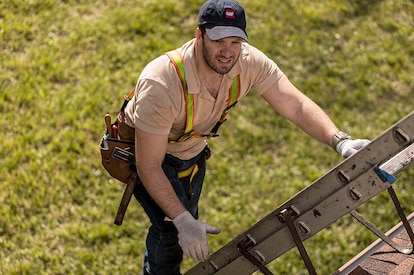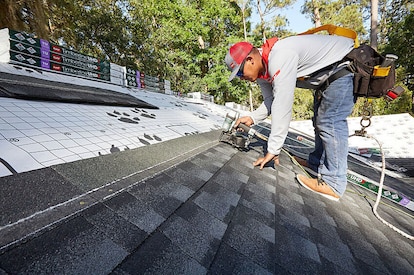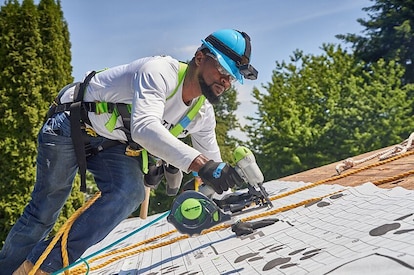
Calculadora de ventilación
Cómo hacer el cálculo
Paso 1: medir
Paso 2: calcular
Paso 3: identificar
Comencemos
Usa esta calculadora como ayuda para determinar la cantidad adecuada de ventilación en el ático, según las normas 1/300 de la FHA de Estados Unidos.*
Sugerencias para una superficie de 900 pies cuadrados
Ten en cuenta:
Ventilación de escape
| Producto | Se necesitan los pies lineales |
|---|---|
| Cobra® RidgeRunner® | 31' |
| Rigid Vent 3™ Cobra® | 22' |
| Cobra® SnowCountry® | 22' |
| Cobra® SnowCountry® Advanced | 22' |
| Ventilación de limatesa Cobra® | 43' |
| Ventilación de caballete TruSlate® | 43' |
Producto
Cobra® RidgeRunner®
Se necesitan los pies lineales
31'
Producto
Rigid Vent 3™ Cobra®
Se necesitan los pies lineales
22'
Producto
Cobra® SnowCountry®
Se necesitan los pies lineales
22'
Producto
Cobra® SnowCountry® Advanced
Se necesitan los pies lineales
22'
Producto
Ventilación de limatesa Cobra®
Se necesitan los pies lineales
22'
Producto
Ventilación de caballete TruSlate®
Se necesitan los pies lineales
22'
| Producto | Se necesitan los pies lineales |
|---|---|
| Respiradero de escape Cobra® - Clavado manual | 31' |
| Respiradero de escape Cobra® - Clavado con pistola | 22' |
Producto
Respiradero de escape Cobra® - Clavado manual
Se necesitan los pies lineales
31'
Producto
Respiradero de escape Cobra® - Clavado con pistola
Se necesitan los pies lineales
22'
| Producto | Se necesitan los pies lineales |
|---|---|
| AR10 | 31' |
Producto
AR10
Se necesitan los pies lineales
31'
| Producto | Cantidad requerida |
|---|---|
| Cuadrado plástico RT65 - Superficie | 31 |
| Inclinación plástica IR61 - Negro | 31 |
| Uso general de metal R50/RV50 | 31 |
| Inclinación plástica IR65 - Negro | 31 |
| Inclinación de metal SSB960 - Negro | 31 |
| Ventilación para domo de alta capacidad HCD144 | 31 |
Producto
Cuadrado plástico RT65 - Superficie
Cantidad requerida
31
Producto
Inclinación plástica IR61 - Negro
Cantidad requerida
31
Producto
Uso general de metal R50/RV50
Cantidad requerida
31
Producto
Inclinación plástica IR65 - Negro
Cantidad requerida
31
Producto
Inclinación de metal SSB960 - Negro
Cantidad requerida
31
Producto
Ventilación para domo de alta capacidad HCD144
Cantidad requerida
31
Ventilación de entrada
| Producto | Se necesitan los pies lineales |
|---|---|
| Cobra IntakePro® | 31' |
Producto
Cobra IntakePro®
Se necesitan los pies lineales
31'
Producto
Respiradero de imposta Cobra® (rollo de malla) 1"
Se necesitan los pies lineales
22'
Producto
Respiradero de imposta Cobra® (rollo de malla) 1.5"
Se necesitan los pies lineales
22'
| Producto | Cantidad requerida |
|---|---|
| Ventilaciones de sofito continuas de metal LSV8 (pies lineales) | 31' |
| Ventilaciones plásticas de sofito EAP 4x12 | 31 |
| Ventilaciones de metal de sofito EAC 16x4 | 31 |
| Ventilaciones de metal de sofito EAC 16x8 | 31 |
| Respiraderos de sofito con cierre EmberShield® | 31 |
Producto
Respiraderos de sofito continuos de metal LSV8
Cantidad requerida
31
Producto
Ventilaciones plásticas de sofito EAP 4x12
Cantidad requerida
22
Producto
Ventilaciones de metal de sofito EAC 16x4
Cantidad requerida
22
Producto
Ventilaciones de metal de sofito EAC 16x8
Cantidad requerida
22
Producto
Respiraderos de sofito con cierre EmberShield®
Cantidad requerida
22
Ventilación de entrada o escape
Nota: las rejillas para techos a dos aguas normalmente se instalan en pares
| Producto | Cantidad requerida |
|---|---|
| DA 12x12 | 31 |
| DA 12x18 | 31 |
| DA 14x24 | 31 |
| DA 18x24 | 31 |
| DA 24x30 | 31 |
Producto
DA 12x12
Cantidad requerida
31
Producto
DA 12x18
Cantidad requerida
31
Producto
DA 14x24
Cantidad requerida
31
Producto
DA 18x24
Cantidad requerida
32
Producto
DA 24x30
Cantidad requerida
33
| Producto | Cantidad requerida |
|---|---|
| SL 8x8 | 31 |
| SL 12x12 | 31 |
| SL 12x18 | 31 |
| SL 18x24 | 31 |
Producto
SL 8x8
Cantidad requerida
34
Producto
SL 12x12
Cantidad requerida
35
Producto
SL 12x18
Cantidad requerida
36
Producto
SL 14x24
Cantidad requerida
37
Producto
SL 18x24
Cantidad requerida
38
| Producto | Cantidad requerida |
|---|---|
| RLSC 2" | 31 |
| RLSC 3" | 31 |
| RLSC 4" | 31 |
Producto
RLSC 2"
Cantidad requerida
39
Producto
RLSC 3"
Cantidad requerida
40
Producto
RLSC 4"
Cantidad requerida
41
Ventilación de escape
| Producto | Cantidad requerida |
|---|---|
| ERV4 | 31 |
| ERV5 & Wi-Fi ERV5QCT | 22 |
| ERV6 | 22 |
| EZ Cool™ EZCR1 | 22 |
Producto
ERV4
Cantidad requerida
31
Producto
ERV5 & Wi-Fi ERV5QCT
Cantidad requerida
22
Producto
ERV6
Cantidad requerida
31
Producto
EZ Cool™ EZCR1
Cantidad requerida
31
| Producto | Cantidad requerida |
|---|---|
| EGV5 & Wi-Fi EGV5QCT | 31 |
| EGV6 | 22 |
| EZ Cool™ EZCG1 | 22 |
Producto
EGV5 & Wi-Fi EGV5QCT
Cantidad requerida
31
Producto
EGV6
Cantidad requerida
31
Producto
EZ Cool™ EZCG1
Cantidad requerida
31
| Producto | Cantidad requerida |
|---|---|
| Techo solar y con alimentación dual (ERVSOLAR / ERVHYBRID) | 31 |
| Techo a dos aguas solar (PGSOLAR) | 22 |
| Techo solar de alta potencia y con alimentación dual (PRSOLAR2 / PRHYBRID2) | 22 |
Producto
Techo solar y con alimentación dual (ERVSOLAR / ERVHYBRID)
Cantidad requerida
31
Producto
Techo a dos aguas solar (PGSOLAR)
Cantidad requerida
31
Producto
Techo solar de alta potencia y con alimentación dual (PRSOLAR2 / PRHYBRID2)
Cantidad requerida
31
| Producto | Cantidad requerida |
|---|---|
| 12" | 31 |
| 14" | 22 |
Producto
12"
Cantidad requerida
31
Producto
14"
Cantidad requerida
31
Ventilación de entrada
| Producto | Se necesitan los pies lineales |
|---|---|
| con ERV4 | 31' |
| con ERV5 y Wi-Fi ERV5QCT | 22' |
| con ERV6 | 31' |
| con EZ Cool™ EZCR1 | 31' |
| con EGV5 & Wi-Fi EGV5QCT | 22' |
| con EGV6 | 31' |
| con EZ Cool™ EZCG1 | 31' |
| con techo solar y con alimentación dual | 22' |
| con techo solar a dos aguas | 22' |
| con techo solar de alta potencia y alimentación dual | 22' |
| con turbina de viento de 12" | 22' |
| con turbina de viento de 14" | 22' |
Producto
con ERV4
Se necesitan los pies lineales
31'
Producto
con ERV5 y Wi-Fi ERV5QCT
Se necesitan los pies lineales
31'
Producto
con ERV6
Se necesitan los pies lineales
31'
Producto
con EZ Cool™ EZCR1
Se necesitan los pies lineales
31'
Producto
con EGV5 & Wi-Fi EGV5QCT
Se necesitan los pies lineales
31'
Producto
con EGV6
Se necesitan los pies lineales
31'
Producto
con EZ Cool™ EZCG1
Se necesitan los pies lineales
31'
Producto
con techo solar y con alimentación dual
Se necesitan los pies lineales
31'
Producto
con techo solar a dos aguas
Se necesitan los pies lineales
31'
Producto
con techo solar de alta potencia y alimentación dual
Se necesitan los pies lineales
31'
Producto
con turbina de viento de 12"
Se necesitan los pies lineales
31'
Producto
con turbina de viento de 14"
Se necesitan los pies lineales
31'
| Producto | Se necesitan los pies lineales |
|---|---|
| con ERV4 | 31' |
| con ERV5 y Wi-Fi ERV5QCT | 22' |
| con ERV6 | 31' |
| con EZ Cool™ EZCR1 | 31' |
| con EGV5 & Wi-Fi EGV5QCT | 22' |
| con EGV6 | 31' |
| con EZ Cool™ EZCG1 | 31' |
| con techo solar y con alimentación dual | 22' |
| con techo solar a dos aguas | 22' |
| con techo solar de alta potencia y alimentación dual | 22' |
| con turbina de viento de 12" | 22' |
| con turbina de viento de 14" | 22' |
Producto
con ERV4
Se necesitan los pies lineales
31'
Producto
con ERV5 y Wi-Fi ERV5QCT
Se necesitan los pies lineales
31'
Producto
con ERV6
Se necesitan los pies lineales
31'
Producto
con EZ Cool™ EZCR1
Se necesitan los pies lineales
31'
Producto
con EGV5 & Wi-Fi EGV5QCT
Se necesitan los pies lineales
31'
Producto
con EGV6
Se necesitan los pies lineales
31'
Producto
con EZ Cool™ EZCG1
Se necesitan los pies lineales
31'
Producto
con techo solar y con alimentación dual
Se necesitan los pies lineales
31'
Producto
con techo solar a dos aguas
Se necesitan los pies lineales
40'
Producto
con techo solar de alta potencia y alimentación dual
Se necesitan los pies lineales
31'
Producto
con turbina de viento de 12"
Se necesitan los pies lineales
31'
Producto
con turbina de viento de 14"
Se necesitan los pies lineales
31'
| Producto | Cantidad requerida |
|---|---|
| con ERV4 | 31 |
| con ERV5 y Wi-Fi ERV5QCT | 22 |
| con ERV6 | 31 |
| con EZ Cool™ EZCR1 | 31 |
| con EGV5 & Wi-Fi EGV5QCT | 22 |
| con EGV6 | 31 |
| con EZ Cool™ EZCG1 | 31 |
| con techo solar y con alimentación dual | 22 |
| con techo solar a dos aguas | 22 |
| con techo solar de alta potencia y alimentación dual | 22 |
| con turbina de viento de 12" | 22 |
| con turbina de viento de 14" | 22 |
Producto
con ERV4
Cantidad requerida
31
Producto
con ERV5 y Wi-Fi ERV5QCT
Cantidad requerida
31
Producto
con ERV6
Cantidad requerida
31
Producto
con EZ Cool™ EZCR1
Cantidad requerida
31
Producto
con EGV5 & Wi-Fi EGV5QCT
Cantidad requerida
31
Producto
con EGV6
Cantidad requerida
31
Producto
con EZ Cool™ EZCG1
Cantidad requerida
31
Producto
con techo solar y con alimentación dual
Cantidad requerida
31
Producto
con techo solar a dos aguas
Cantidad requerida
49
Producto
con techo solar de alta potencia y alimentación dual
Cantidad requerida
31
Producto
con turbina de viento de 12"
Cantidad requerida
31
Producto
con turbina de viento de 14"
Cantidad requerida
31
| Producto | Cantidad requerida |
|---|---|
| con ERV4 | 31 |
| con ERV5 y Wi-Fi ERV5QCT | 22 |
| con ERV6 | 31 |
| con EZ Cool™ EZCR1 | 31 |
| con EGV5 & Wi-Fi EGV5QCT | 22 |
| con EGV6 | 31 |
| con EZ Cool™ EZCG1 | 31 |
| con techo solar y con alimentación dual | 22 |
| con techo solar a dos aguas | 22 |
| con techo solar de alta potencia y alimentación dual | 22 |
| con turbina de viento de 12" | 22 |
| con turbina de viento de 14" | 22 |
Producto
con ERV4
Cantidad requerida
31
Producto
con ERV5 y Wi-Fi ERV5QCT
Cantidad requerida
31
Producto
con ERV6
Cantidad requerida
31
Producto
con EZ Cool™ EZCR1
Cantidad requerida
31
Producto
con EGV5 & Wi-Fi EGV5QCT
Cantidad requerida
31
Producto
con EGV6
Cantidad requerida
31
Producto
con EZ Cool™ EZCG1
Cantidad requerida
31
Producto
con techo solar y con alimentación dual
Cantidad requerida
31
Producto
con techo solar a dos aguas
Cantidad requerida
58
Producto
con techo solar de alta potencia y alimentación dual
Cantidad requerida
31
Producto
con turbina de viento de 12"
Cantidad requerida
31
Producto
con turbina de viento de 14"
Cantidad requerida
31
| Producto | Cantidad requerida |
|---|---|
| con ERV4 | 31 |
| con ERV5 y Wi-Fi ERV5QCT | 22 |
| con ERV6 | 31 |
| con EZ Cool™ EZCR1 | 31 |
| con EGV5 & Wi-Fi EGV5QCT | 22 |
| con EGV6 | 31 |
| con EZ Cool™ EZCG1 | 31 |
| con techo solar y con alimentación dual | 22 |
| con techo solar a dos aguas | 22 |
| con techo solar de alta potencia y alimentación dual | 22 |
| con turbina de viento de 12" | 22 |
| con turbina de viento de 14" | 22 |
Producto
con ERV4
Cantidad requerida
31
Producto
con ERV5 y Wi-Fi ERV5QCT
Cantidad requerida
31
con ERV6
Cantidad requerida
31
con EZ Cool™ EZCR1
Cantidad requerida
31
con EGV5 & Wi-Fi EGV5QCT
Cantidad requerida
31
con EZ Cool™ EZCG1
Cantidad requerida
31
con techo solar y con alimentación dual
Cantidad requerida
31
con techo solar a dos aguas
Cantidad requerida
67
con techo solar de alta potencia y alimentación dual
Cantidad requerida
31
con turbina de viento de 12"
Cantidad requerida
31
con turbina de viento de 14"
Cantidad requerida
31
| Producto | Cantidad requerida |
|---|---|
| con ERV4 | 31 |
| con ERV5 y Wi-Fi ERV5QCT | 22 |
| con ERV6 | 31 |
| con EZ Cool™ EZCR1 | 31 |
| con EGV5 & Wi-Fi EGV5QCT | 22 |
| con EGV6 | 31 |
| con EZ Cool™ EZCG1 | 31 |
| con techo solar y con alimentación dual | 22 |
| con techo solar a dos aguas | 22 |
| con techo solar de alta potencia y alimentación dual | 22 |
| con turbina de viento de 12" | 22 |
| con turbina de viento de 14" | 22 |
Producto
con ERV4
Cantidad requerida
31
Producto
con ERV5 y Wi-Fi ERV5QCT
Cantidad requerida
31
Producto
con ERV6
Cantidad requerida
31
Producto
con EZ Cool™ EZCR1
Cantidad requerida
31
Producto
con EGV5 & Wi-Fi EGV5QCT
Cantidad requerida
31
Producto
con EGV6
Cantidad requerida
31
Producto
con EZ Cool™ EZCG1
Cantidad requerida
31
Producto
con techo solar y con alimentación dual
Cantidad requerida
31
Producto
con techo solar a dos aguas
Cantidad requerida
75
Producto
con techo solar de alta potencia y alimentación dual
Cantidad requerida
31
Producto
con turbina de viento de 12"
Cantidad requerida
31
Producto
con turbina de viento de 14"
Cantidad requerida
31
Productos de respiradero y ventilación para ático
Para encontrar la solución de ventilación para ático adecuada para tu proyecto de techado, elige entre una línea completa de respiraderos para techos a cuatro aguas y de caballete, respiraderos de energía solar y eléctricos, rejillas para techo y techo a dos aguas, turbinas de viento, respiraderos de entrada y más, todo de GAF.







La regla de ventilación equilibrada para ático de 1/300

Conoce las opciones de respiradero para ático
Respuestas para tus principales preguntas sobre ventilación para ático
.jpg?as=0&w=510&hash=DC23D30D23AAE7357E4D1AD84F32C60C)
Cómo ventilar un ático: cómo funciona la ventilación para ático | GAF Roofing

Cómo seleccionar productos para tu sistema de ventilación para ático | GAF Roofing

Cómo planificar un sistema equilibrado de ventilación para ático | GAF Roofing Materials



